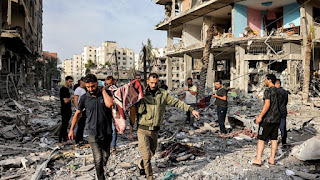Israel-Hamas War: The Last Report Published October 10, 2024
Israel-Hamas War: The Last Report Published October 10, 2024
The war between Israel and Hamas is at a very critical level, passing exactly one year since the catastrophic attack by Hamas on Israel on October 7, 2023. This war that triggered the year of the war displays increasing violence in the past few days with no visible solution for peace; here's the last report as of October 10, 2024:
Recent Escalations
The past weeks have witnessed very hot confrontation between Israel and Hamas, where the death tolls rise astronomically from both camps. Israeli forces continue to carry out raids across Gaza, targeting military infrastructure, while Hamas sends back daily rocket fire into Israeli cities, inflicting extensive destruction and death among civilians. Meanwhile, Hezbollah has been drawn into the conflict, attacking from Lebanon, thus complicating war for Israel since it now fights on two fronts.
Israeli Ground and Air Campaigns
The Israeli army has made considerable advances with land operations in Gaza, with soldiers into the cities to dismantle Hamas's tunnel complex and the disparate rocket launching sites. Casualties as reported due to airstrikes have left several high-ranking Hamas leaders dead, but its military unit is still operational. Thousands of civilians trapped inside Gaza have lost their lives, while millions are compelled to live under urgent circumstances and parts of infrastructure critical to living standards destroyed from bombardments by the Israeli forces, including hospitals, schools, and camps for refugees.
Israeli air forces struck southern Lebanon targets on 9 October 2024, targeting posts held by Hezbollah, which had been launching rocket attacks against northern Israel (The Jerusalem Post ). According to the IDF, the attacks are in retaliation for Hezbollah's efforts to open up a new front in the north.
Humanitarian Crisis
The war has intensified a humanitarian crisis. More than 40,000 Palestinians have been killed, although many more are injured. At the moment, health care infrastructure in Gaza is on the brink of collapse. Hospitals are running out of medication; they are overwhelmed by wounded patients, and burnout. This is reportedly so on the Israeli side as well: over 1,100 dead, thousands displaced, but the big story is the widespread destruction of communities in the south from rocket fire and ground attacks. Many civilians on both sides are displaced and scrambling to take shelter as rounds of attacks continue.
Hamas Strategy
The Hamas continues launching rocket attacks that have included Tel Aviv and other major cities in Israel, even though it has sustained great losses. Its other high-tech methods, including suicide bombings and infiltration armed into Israel, have been growing in importance. Yahya Sinwar, the Hamas's leader in Gaza, signaled a shift in strategy when he announced the resumption of suicide bombings.
For example, the international community, from the UN and European Union, has expressed that a unilateral and unconditional ceasefire is in place. So far, this has never come to fruition with the help of any form of diplomacy. Israel wants to continue their attacks until all capabilities of Hamas are degraded completely; Hamas wants the blockade on Gaza lifted and Israeli forces out of Palestine.
The U.S. and its allies expressed their support for Israel's right to defend itself, but at the same time expressed concern over the ever-growing civilian casualties in Gaza, as regional players like Iran continued their support for Hamas, increasing the difficulty in the way of a peaceful resolution.
Outlook
As of October 10, 2024, Israel-Hamas conflict remains unstable. The war has no visible end, yet with crises piling pressure on both sides to negotiate, far off can be the result of such entrenched positions and the continued violence. In the meantime, this region experiences one of the deadliest conflicts in history; civilians are not even spared from the suffering.
The war between Hamas and Israel has redefined the political topography of the Middle East. Needless to say, such conflicts instill fears of further instability in regions. Since the two parties entrenched themselves and managed to stay, it seems that peace might be a far cry, leaving millions to suffer at the hands of this ongoing war.







Comments
Post a Comment